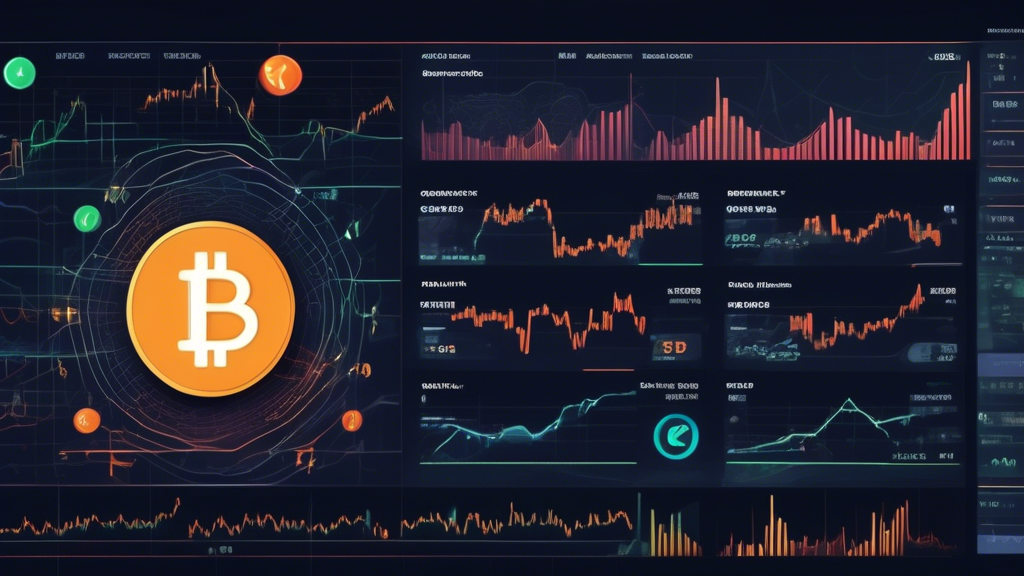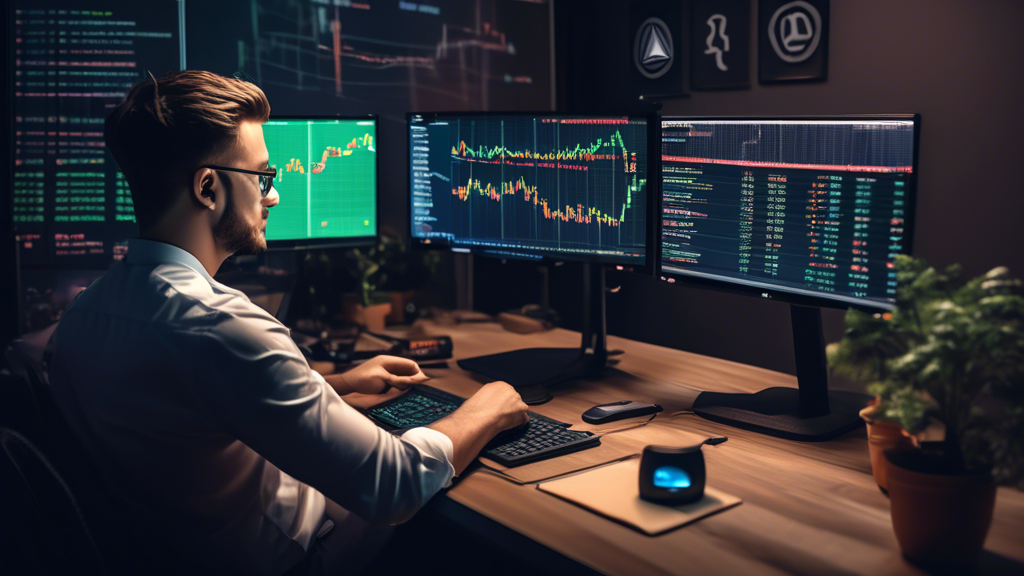Understanding Margin Trading in Crypto: Risks and Rewards What is Margin Trading in Crypto? A…
Understanding the Relationship Between Crypto Trading and Volatility

Understanding the intricate relationship between crypto trading and volatility is crucial for anyone involved in the digital asset market. Crypto trading, the act of buying and selling cryptocurrencies like Bitcoin, Ethereum, and other digital coins, has garnered immense popularity over the past decade. This surge in interest is largely due to the market’s potential for high returns. However, this potential comes hand-in-hand with significant volatility. Volatility in financial markets refers to the degree of variation in the price of a financial instrument over time. It is characterized by rapid and unpredictable price swings, making it a double-edged sword for traders and investors alike.
Understanding the relationship between crypto trading and volatility is paramount. Cryptocurrency markets are notoriously volatile compared to traditional financial markets. This volatility can be both an opportunity and a risk, impacting trading decisions, strategies, and overall market behavior. For traders, the ability to navigate these volatile waters can mean the difference between substantial gains and significant losses.
Several factors contribute to the volatility seen in crypto markets. Market sentiment and speculation, often driven by social media and influential figures, can cause rapid price changes. Regulatory news and developments, such as government regulations or bans, can also lead to substantial market movements. Technological changes and innovations, which are frequent in the rapidly evolving crypto space, similarly influence market volatility. Additionally, economic indicators and global events play a role, as they can affect investor confidence and market stability.
Given this volatility, its impact on crypto trading strategies needs careful consideration. Day trading, which involves making multiple trades within a single day to capitalize on price fluctuations, contrasts sharply with long-term investing, where assets are held for extended periods despite short-term volatility. Managing risk in such volatile markets requires specific techniques, such as setting stop-loss orders and diversifying portfolios. Additionally, some traders aim to capitalize on volatility through strategies designed to exploit price movements.
Looking to the future, the landscape of crypto trading and volatility is likely to evolve. Predictions for market stability range widely, but emerging technologies such as blockchain improvements and more sophisticated trading algorithms could lead to reduced volatility over time. Consequently, the long-term outlook for crypto traders and investors remains both challenging and promising, as they must stay adaptable to the ever-changing market dynamics influenced by both intrinsic and extrinsic factors.
For further reading on this topic, you may find these resources valuable:
– [Investopedia’s Introduction to Cryptocurrency Trading](https://www.investopedia.com/terms/c/cryptocurrency.asp)
– [The Volatility of Cryptocurrencies: An Overview](https://finance.yahoo.com/news/volatility-cryptocurrencies-174200921.html)
– [Risk Management Techniques for Crypto Traders](https://www.binance.com/en/blog/421499824684900580/Risk-Management-Techniques-for-Crypto-Traders)
By grasping the elements of volatility and its effects on crypto trading, market participants can better equip themselves to navigate the tumultuous yet rewarding world of cryptocurrencies.
Introduction to Crypto Trading and Volatility
What is Crypto Trading?
Crypto trading involves the buying, selling, and exchanging of cryptocurrencies on various exchanges with the aim of making a profit. The cryptocurrency market operates differently from traditional financial markets, often providing opportunities for rapid gains due to its highly dynamic nature. Some key characteristics of crypto trading include:
- 24/7 Market: Unlike traditional stock markets, crypto markets never close, offering continuous trading opportunities.
- Variety of Assets: Traders can choose from a myriad of cryptocurrencies like Bitcoin, Ethereum, and numerous altcoins.
- Decentralization: Cryptocurrencies operate on decentralized networks, which means they are not controlled by any central authority like banks or governments.
Defining Volatility in Financial Markets
Volatility refers to the degree of variation in the price of a financial instrument over time. It is usually measured by the standard deviation of returns. In simpler terms, volatility indicates how much and how quickly an asset’s price can change. High volatility means that the price of an asset can change dramatically in a short period, while low volatility suggests steadier price movements. Key metrics and terms related to volatility include:
- Volatility Index (VIX): Often referred to as the ‘Fear Index,’ the VIX measures market risk and investor sentiment. Though primarily associated with traditional markets, similar concepts apply to cryptocurrencies.
- Standard Deviation: A statistical measure that quantifies the amount of variation in a set of data points, used to assess volatility.
- Beta: A measure of an asset’s volatility in relation to the market as a whole.
Importance of Understanding the Relationship Between Crypto Trading and Volatility
Understanding the relationship between crypto trading and volatility is crucial for several reasons:
- Risk Management: High volatility can lead to significant gains but also to substantial losses. Knowledge of volatility helps traders implement effective risk management strategies.
- Market Timing: Accurate perception of market volatility can aid traders in timing their buy and sell orders more effectively.
- Informed Decision-Making: A clear grasp of volatility and its impacts enables traders to make more informed decisions, reducing emotional and impulsive trading.
- Strategic Planning: Understanding trends and historical volatility allows traders to develop and optimize their trading strategies, enhancing their chances of success.
For further reading on the concepts of volatility, you might find the following resources useful:
- Understanding Volatility by Investopedia
- Cryptocurrency Trends in 2022 by CB Insights

Factors Contributing to Volatility in Crypto Markets
Understanding the relationship between crypto trading and volatility is crucial for anyone engaging in the cryptocurrency market. Various factors contribute to the often dramatic price swings observed in cryptocurrencies. Below, we delve into the main contributors to crypto volatility:
Market Sentiment and Speculation
Market sentiment and speculation are among the most significant drivers of volatility in crypto markets. Here’s how they play a role:
- Influence of Public Opinion: Cryptocurrency prices can be highly susceptible to changes in investor sentiment. Positive news or endorsements can drive prices up, while negative reports or criticisms can lead to sharp declines.
- Social Media and Online Forums: Platforms like Twitter, Reddit, and specialized crypto forums can amplify trends. Viral posts and discussions often lead to quick, significant price movements.
- FOMO and FUD: Fear of Missing Out (FOMO) and Fear, Uncertainty, and Doubt (FUD) are prevalent phenomena in the crypto space. These emotional responses can lead to impulsive buying or selling, thus contributing to volatility.
- Trading Volume: Higher trading volumes generally indicate more participants and can either stabilize prices or contribute to rapid fluctuations depending on market conditions.
Regulatory News and Developments
Regulatory environments around the world play a critical role in crypto market volatility. Key aspects include:
- Government Announcements: News about potential regulatory changes, such as bans or endorsements of certain cryptocurrencies, can significantly impact market dynamics.
- Legal Frameworks: Different countries have varying approaches to cryptocurrency regulation. Strict regulations can dampen investor enthusiasm, while supportive laws can boost market sentiment.
- Institutional Adoption: The entry of institutional investors often lends more stability due to larger, more strategic investments, but announcements on institutional policy can also cause substantial market reactions.
- Security Concerns: Regulations aimed at preventing fraud, money laundering, and other illegal activities can influence market confidence and, consequently, volatility.
Learn more about the impact of regulations on cryptocurrencies.
Technological Changes and Innovations
Technological advancements also play a crucial role in affecting the volatility of crypto markets. Consider the following points:
- Blockchain Technology Improvements: Updates and forks in blockchain technologies can cause price fluctuations. For example, the anticipation of Ethereum’s move from Proof-of-Work to Proof-of-Stake created significant market activity.
- New Cryptocurrencies: The introduction of new coins and tokens can shift market focus and capital, causing existing cryptocurrencies to experience price changes.
- Security Breaches: Hacks and security breaches in crypto exchanges or wallets can induce panic selling, leading to sharp drops in prices.
- Decentralized Finance (DeFi): Innovations within DeFi ecosystems, like the development of new financial products and services, can also contribute to market volatility.
Explore more about DeFi innovations.
Economic Indicators and Global Events
Broader economic indicators and global events impact the volatility in crypto markets in several ways:
- Macroeconomic Trends: Inflation rates, interest rates, and overall economic health influence investor behavior. For instance, inflationary fears might drive more people towards cryptocurrencies as a hedge, thereby increasing volatility.
- Global Pandemics and Crises: Events like the COVID-19 pandemic have shown how global crises can significantly impact crypto markets. Uncertainty in traditional financial systems often propels investors towards cryptocurrencies.
- Geopolitical Tensions: Political instability, wars, and other geopolitical tensions can cause investors to seek alternatives to traditional assets, affecting the demand and supply balance in the crypto markets.
- Economic Policies: Monetary policies, especially those related to quantitative easing or tightening, can profoundly impact cryptocurrency markets as they alter the broader financial landscape.
Read about how macroeconomic trends affect cryptocurrency markets.
By understanding these factors, crypto traders can better navigate the uncertainties and capitalize on the opportunities offered by the volatile nature of the crypto markets. This knowledge is crucial for designing effective trading strategies in the ever-evolving world of cryptocurrencies.

Impact of Volatility on Crypto Trading Strategies
Day Trading vs. Long-term Investing
Volatility significantly influences trading strategies in the crypto market. Understanding the difference between day trading and long-term investing is crucial for anyone involved in crypto trading and volatility.
- Day Trading:
Day traders thrive on market fluctuations within a single day. They make multiple trades to capitalize on short-term price movements. High volatility often leads to higher potential profits because of the frequent price swings.
Pros of Day Trading:
- Quick profit opportunities
- Flexibility in terms of trade frequency
- Immediate feedback and results
Cons of Day Trading:
- High risk due to rapid market changes
- Requires constant monitoring and quick decision-making
- High transaction costs due to frequent trades
- Long-term Investing:
Long-term investors focus on the potential growth of investments over extended periods, often years. They are less affected by daily price movements and more concerned with long-term trends.
Pros of Long-term Investing:
- Less stress from daily market fluctuations
- Lower transaction costs
- Potential for significant returns from the overall market growth
Cons of Long-term Investing:
- Longer time horizon for returns
- Potential for significant losses during market downturns
- Requires patience and strong emotional control
Risk Management Techniques for Volatile Markets
Effective risk management is essential for navigating the volatility in crypto trading. Here are some techniques traders use to mitigate risks:
- Stop-Loss Orders:
Setting stop-loss orders helps to automatically sell a cryptocurrency when it reaches a specific price, limiting potential losses.
- Position Sizing:
Adjusting the size of a trade based on the trader’s tolerance for risk can reduce exposure to significant losses.
- Diversification:
Investing in a diversified portfolio of cryptocurrencies can spread risk across different assets, reducing the impact of a single asset’s price drop.
- Hedging:
Using financial derivatives, such as options and futures, can provide a way to hedge against adverse price movements.
- Regular Review and Adjustment:
Constantly reviewing and adjusting strategies based on market conditions can help stay ahead in a volatile market.
How Traders Can Capitalize on Volatility
While volatility presents risks, it also offers numerous opportunities for traders to profit. Here’s how traders can capitalize on market volatility:
- Technical Analysis:
Utilizing technical analysis to study price charts and market indicators can help identify trends and potential entry and exit points.
- Scalping:
Scalping involves making numerous small trades throughout the day to take advantage of price discrepancies, which are more common in volatile markets.
- Arbitrage:
Traders can exploit price differences of the same cryptocurrency on different exchanges through arbitrage trading.
- News Trading:
Keeping up with the latest news and events can provide insights into market sentiment and potential price movements, enabling traders to react swiftly.
- Automated Trading Bots:
Using automated trading bots can execute pre-defined trading strategies 24/7, capitalizing on market opportunities as they arise.
For those looking to deepen their understanding of crypto trading and volatility, resources like Investopedia and CoinDesk Learn offer comprehensive guides and articles.

Future Trends in Crypto Trading and Volatility
Predictions for Crypto Market Stability
Understanding the future trends in crypto trading and volatility involves predicting whether the market will become more stable or continue to be characterized by its notorious fluctuations. Historically, the crypto market has been highly volatile, but several factors suggest a potential stabilization in the future:
- Maturity of the Market: As the crypto market matures, it is likely to experience reduced speculation and more predictable price movements. Increased participation by large institutional investors could contribute to this stability.
- Regulatory Clarity: The implementation of clear and comprehensive regulations could reduce uncertainty and volatility. Regulatory bodies around the world are working to establish rules that can foster market stability and protect investors.
- Increased Adoption: Widespread adoption of cryptocurrencies for everyday transactions and as a viable investment option may lead to more steady and predictable market behavior.
- Market Infrastructure Development: Improved trading platforms, security measures, and other market infrastructure could mitigate risks associated with volatile markets.
Emerging Technologies and their Impact on Volatility
Emerging technologies have the potential to significantly influence crypto trading and volatility. Key technologies to watch include:
- Blockchain Technology Advancements: Enhancements in blockchain technology, such as increased scalability and security, can lead to greater trust in the crypto market, potentially reducing volatility.
- Artificial Intelligence (AI) and Machine Learning: AI and machine learning can analyze market trends and predict price movements, giving traders more tools to manage volatility.
- Decentralized Finance (DeFi): DeFi platforms provide new financial instruments that can democratize access to financial services, potentially leading to less market manipulation and more stability.
- Stabilizing Mechanisms: Technologies such as stablecoins aim to reduce volatility by pegging to stable assets like fiat currency. As these mechanisms evolve, they can offer a hedge against market fluctuations.
Long-term Outlook for Crypto Traders and Investors
The long-term outlook for crypto traders and investors involves both opportunities and challenges. Key considerations include:
- Diversification of Portfolios: Traders and investors may increasingly look to diversify their portfolios beyond Bitcoin and Ethereum to include a mix of altcoins, stablecoins, and other digital assets.
- Regulatory Fidelity: Adhering to and anticipating regulatory changes will be crucial for long-term success. Investors must stay informed about global regulatory landscapes to navigate potential volatility.
- Technological Proficiency: Mastery of emerging technologies and staying current with technological advancements will be critical. Skills in AI, blockchain, and cybersecurity could become integral to successful trading strategies.
- Long-term Adoption: As more businesses and individuals adopt cryptocurrencies, long-term investors might focus on fundamental value rather than short-term price movements, which could provide more stability and predictability.
For further reading on these topics, consider exploring the following resources:
Investopedia on Cryptocurrencies
In conclusion, the intricate relationship between crypto trading and volatility is pivotal for both novice and seasoned traders to grasp. Crypto trading, characterized by the buying and selling of digital currencies, is inherently linked to the notion of volatility, a measure of how much the price of an asset fluctuates over a given period. Understanding this relationship is crucial as it informs traders about potential risks and opportunities within the market. Various factors contribute to volatility in crypto markets, including market sentiment and speculation, regulatory news and developments, technological changes, and broader economic indicators and global events.
Market sentiment and speculation often drive short-term price swings as traders react to news and market trends. Regulatory decisions can also have a profound impact, either stabilizing the market through clear guidelines or introducing volatility through uncertainty. Technological innovations, like advancements in blockchain technology, can lead to increased interest and investment, thereby affecting price stability. Additionally, global economic events and indicators can influence market dynamics, as seen with the fluctuating prices of cryptocurrencies in response to macroeconomic trends.
The impact of volatility on crypto trading strategies cannot be overstated. Traders often adopt different approaches based on their risk tolerance and market outlook. While day traders thrive on short-term price movements and high volatility, long-term investors generally prefer more stable market conditions. Effective risk management techniques, such as diversification, stop-loss orders, and hedging, are essential for navigating volatile markets. Savvy traders can also capitalize on volatility by employing strategies designed to profit from price swings, such as swing trading and arbitrage.
Looking forward, the future trends in crypto trading and volatility are poised to evolve with market maturation and technological advancements. Predicting market stability remains challenging, but increased institutional involvement and regulatory clarity may contribute to reduced volatility. Emerging technologies, including more sophisticated trading algorithms and AI-driven analytics, hold the potential to further influence market dynamics. For long-term investors and traders, maintaining a keen awareness of these developments and their implications for market behavior will be crucial.
Overall, the intertwined nature of crypto trading and volatility underscores the importance of continuous learning and adaptation for market participants. By staying informed about contributing factors, employing effective trading strategies, and anticipating future trends, traders can better navigate the complexities of the crypto market and optimize their investment outcomes.





